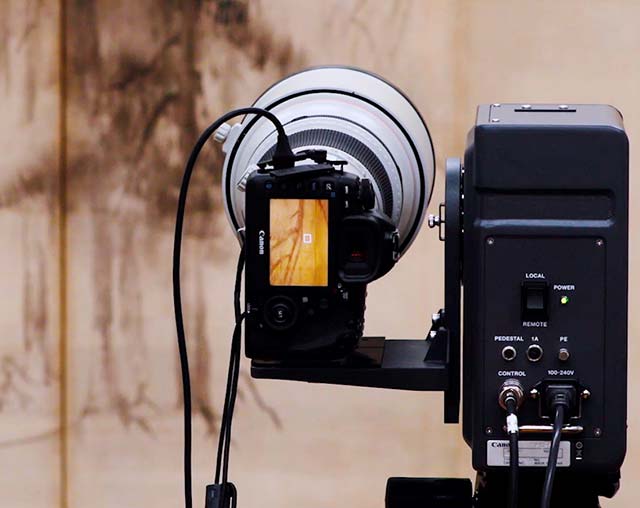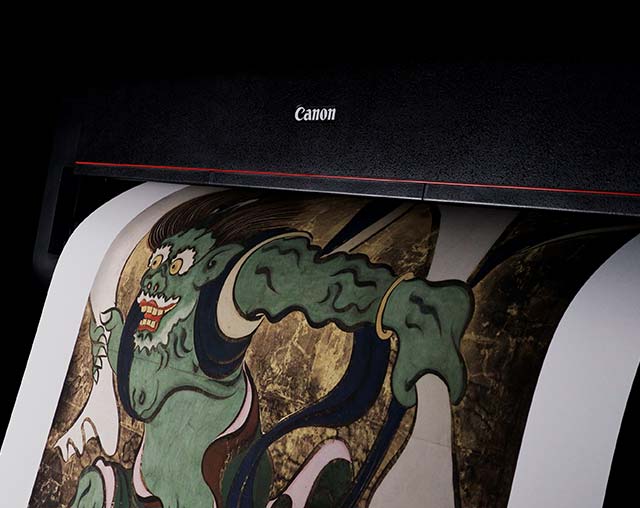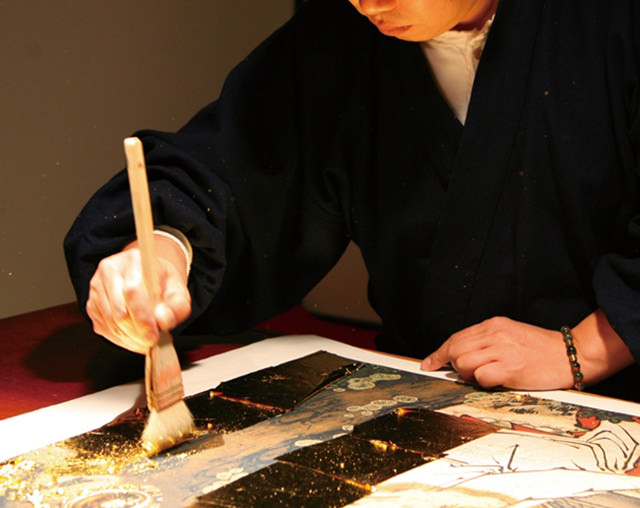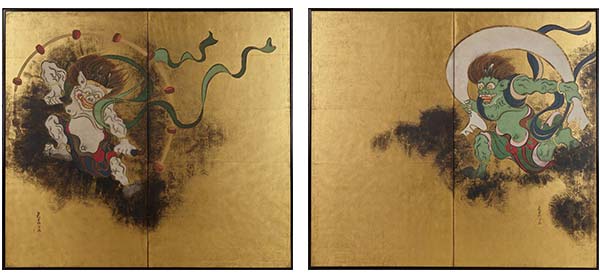
TOKYO, October 13, 2020—Canon Inc. announced today that the Tsuzuri Project (officially, the Cultural Heritage Inheritance Project), a joint project organized by Canon and the Kyoto Culture Association (NPO), donated 5 high-resolution facsimiles of works including "Pine Trees" by Hasegawa Tohaku—the originals of which reside in the collection of the Tokyo National Museum—as part of the project's Stage 13. The facsimiles were donated to the National Institutes for Cultural Heritage and will be displayed at the Tokyo National Museum from October 27.

Pine Trees
Hasegawa Tohaku's Pine Trees depicts a grove of pine trees slipping in and out of view amidst a dense haze—a masterful and elegant expression of an ordinary natural scene—and is considered to be a masterpiece of modern ink and wash paintings. The Tsuzuri Project created and donated a high-resolution facsimile of the work as part of the project's Stage 1 in 2007. However, with Canon's image capturing system able to acquire high-resolution data of approximately 5.4 billion pixels, and after recent upgrades advancements in printing technology, the project has succeeded in producing a high-resolution facsimile that is more faithful to the original work. In addition to Pine Trees, the Tsuzuri Project has produced and donated to the National Institutes for Cultural Heritage 4 high-resolution facsimiles of works from the collection of the Tokyo National Museum as part of Stage 13: Cooling off (national treasure – Kusumi Morikage), Kabuki Theater (important cultural property - Hishikawa Moronobu), Autumn Grasses (important cultural property - Tawaraya Sosetsu) and Namban Ships and Chinese Junks (Kano Takanobu). Thanks to this donation, the original works can be preserved in more ideal environments while the high-resolution facsimiles can be widely used for public display, allowing more people the opportunity to experience the works in person.
The 5 high-resolution facsimiles to be donated will go on display from October 27 to December 6 at the Tokyo National Museum for the exhibitions entitled "Family Gallery: TNM and Art Tunes! Present: Becoming Japanese Art," and at the Kujokan teahouse1." The Becoming Japanese Art exhibition will feature such events as projection mapping of imagery onto high-resolution facsimiles—an experience not possible with the original works. In addition, the exhibit will also include high-resolution facsimiles of the "Wind God and Thunder God" by Ogata Korin and "Flowering Plants of Summer and Autumn" Sakai Hoitsu folding screens, produced by a joint research project with the National Center for the Promotion of Cultural Properties.

National Treasure "Pine Trees" by Hasegawa Tohaku (the originals of which reside in the collection of the Tokyo National Museum)

National Treasure "Cooling off" by Kusumi Morikage (the originals of which reside in the collection of the Tokyo National Museum)

Important Cultural Property "Kabuki Theater" by Hishikawa Moronobu (the originals of which reside in the collection of the Tokyo National Museum)

Important Cultural Property "Autumn Grasses" by Tawaraya Sosetsu (the originals of which reside in the collection of the Tokyo National Museum)

"Nanban Ships and Chinese Junks" by Kano Takanobu (the originals of which reside in the collection of the Kyushu National Museum)
The Tsuzuri Project is a social contribution initiative organized by the Kyoto Culture Association and co-sponsored and promoted by Canon with the goal of preserving original cultural assets and creating high-resolution facsimiles. Combining Canon's technical expertise in imaging, processing and output with the master craftsmanship of traditional Kyoto artisans, the Project produces and donates high-resolution facsimiles of such celebrated historical Japanese cultural assets as folding screens, sliding doors and illustrated scrolls. As of the Project's Stage 11, begun in 2018, the camera and lens equipment used in the process of creating the high-resolution facsimiles have been upgraded2.
The Project began in 2007 with two objectives—to donate high-resolution facsimiles of Japanese art abroad to their original owners, and to create high-resolution facsimiles of historical cultural assets that appear in school textbooks for use as tangible educational materials to teach primary and secondary school students about Japan's history, art and culture. Different works from artists including Katsushika Hokusai, Tawaraya Sotatsu and Ogata Korin, have been selected every year since, with the 5 works most recently donated as the Project's 52nd through 56th facsimiles.
For more information, please visit the official Tsuzuri Project website.
URL:https://global.canon/en/tsuzuri/
Input |
Capturing high-resolution digital dataA digital SLR camera is used to capture high-image-quality data for output in the actual size and dimensions of the original cultural artifact. The camera is mounted on a specially designed turntable, enabling it to capture segmented portions of the original work, which are then digitally stitched into a single high-resolution image file. |
Color matching |
Highly accurate color matching systemThe high-resolution data is digitally processed using Canon's proprietary color matching system, which corrects for inherent differences in the lighting environment where the work was photographed. The image is printed and colors are matched on location, helping to minimize both technicians' workload and the wear on the original cultural artifact. |
Output |
World's highest level of printing technologyJapanese art expresses a dimensional depth through its delicate tonal subtleties and shading. These are recreated using Canon's imagePROGRAF large-format inkjet printer, which outputs the data onto washi or silk paper that we have specially designed to be ideally suited for printing facsimiles of the cultural artifacts and applying such finishes as gold leaf. |
Gold leaf, gold paint & isinglass |
Reproduced through time-honored and traditional techniquesAuthentic Kyoto Nishijin craftsmen reproduce the most significant features used in Japanese cultural artifacts—gold leaf, gold paint and isinglass. Special "color fading" techniques recreate the effects that time has had on the gold leaf. |
Mounting |
A discipline developed in KyotoA master Kyoto framer carefully mounts the output and finished facsimile using traditional Japanese tools. Great care is taken to recreate fading in the metalwork and fabric used in folding screens, while sliding door panels are installed exactly as they were in their original locations. |
This event will feature high-resolution facsimiles of "Pine Trees," created as part of Stage 13 of the Tsuzuri Project, and "Wind God and Thunder God / Flowering Plants of Summer and Autumn" created through a joint research project3 between Canon and the National Center for the Promotion of Cultural Properties. The event includes various displays that would be difficult to achieve using the original works, such as projection mapping onto folding screens, allowing all-new art experiences that fuse original artwork with digital content. In addition, the important cultural properties "Wind God and Thunder God" (Ogata Korin) and "Flowering Plants of Summer and Autumn" (Sakai Hoitsu) are both pairs of two-fold screens and feature the same imagery on both sides of the screen. Currently, the front and back sides of the originals have been separated in order to facilitate preservation in storage. The high-resolution facsimiles have been produced according to their original configuration, allowing them to be viewed from either side.

Important Cultural Property "Wind God and Thunder God" by Ogata Korin (the originals of which reside in the collection of the Tokyo National Museum)

Important Cultural Property "Flowering plants of summer and autumn" by Sakai Hoitsu (the originals of which reside in the collection of the Tokyo National Museum)